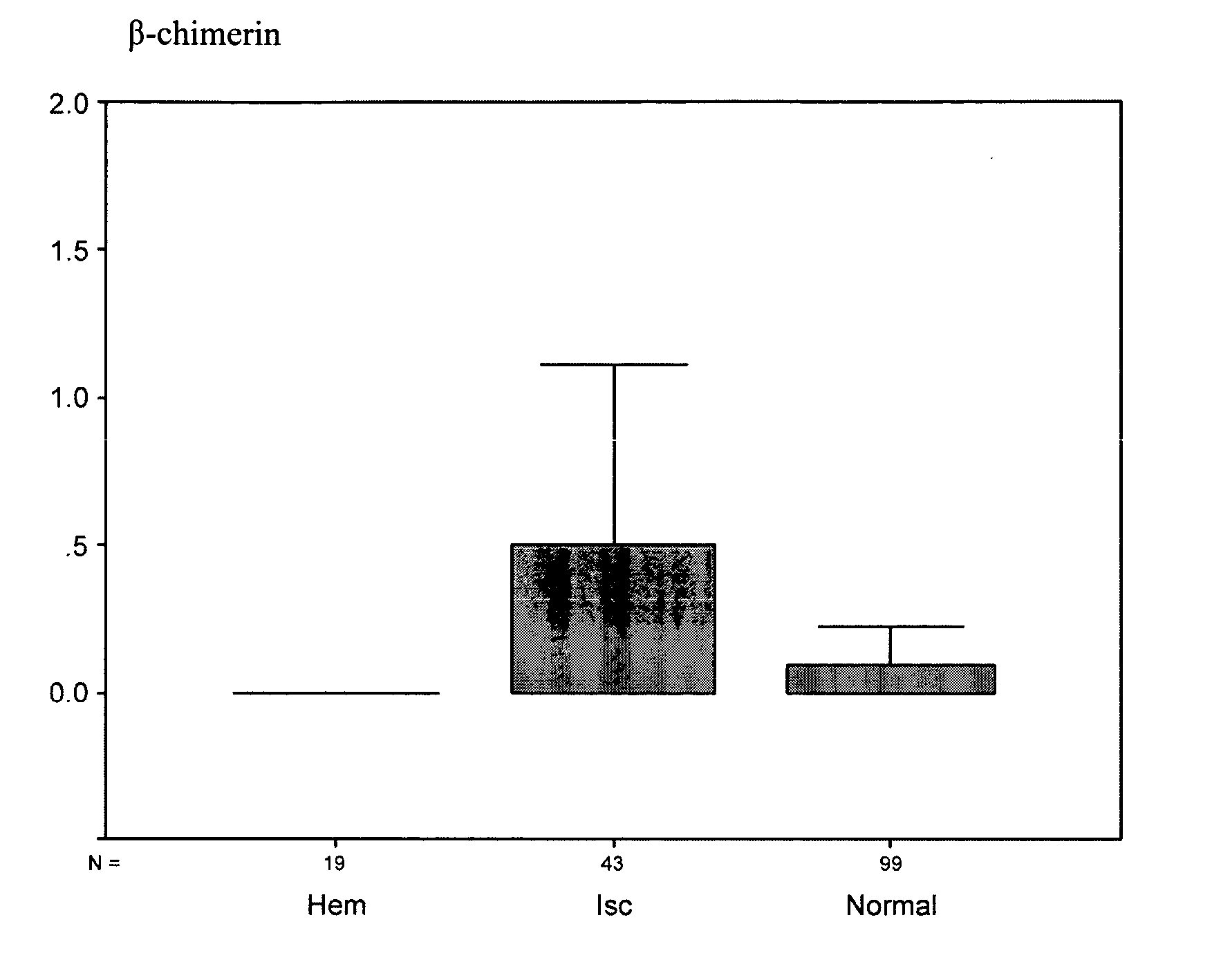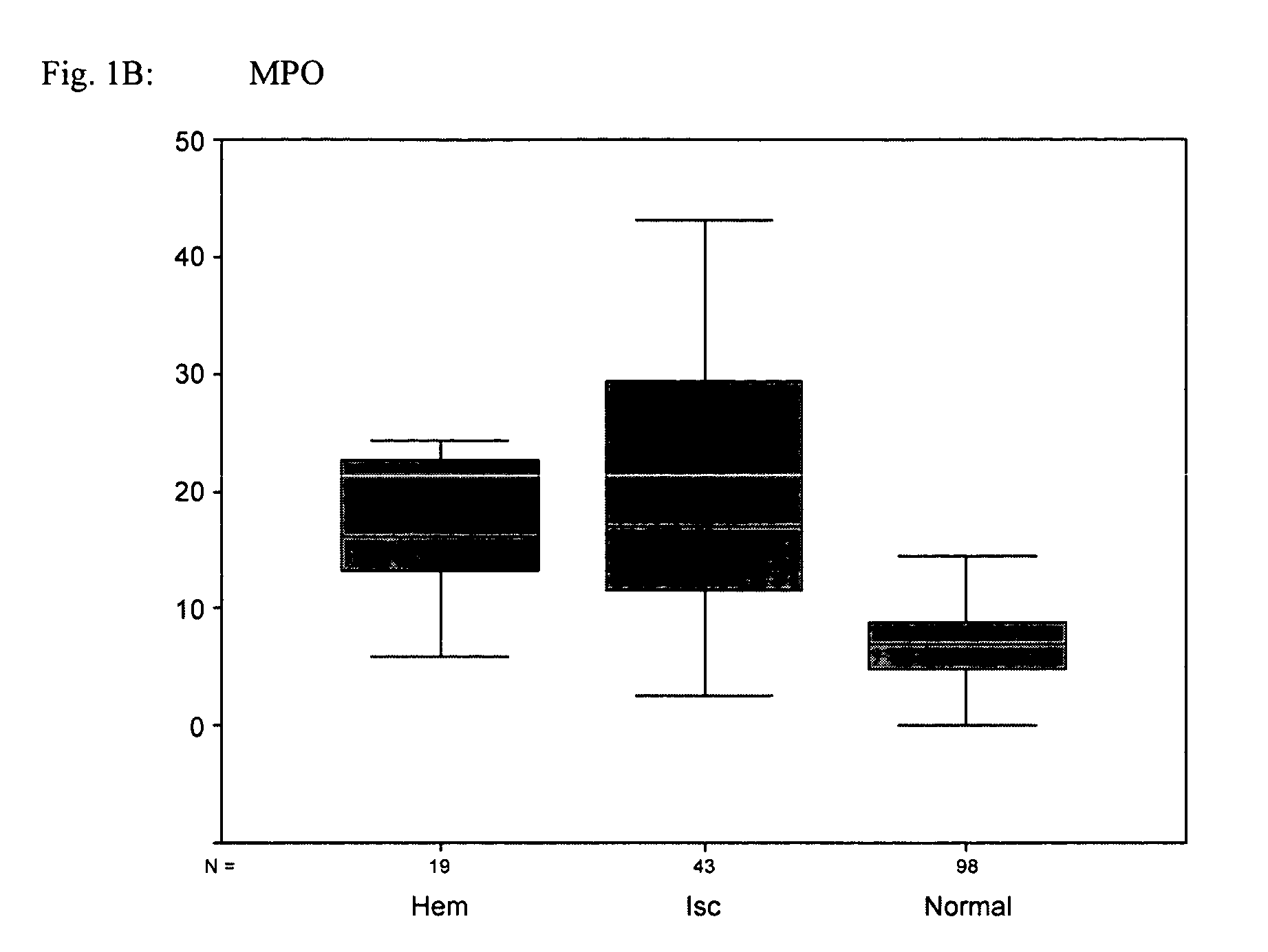Diagnostic markers of stroke and cerebral injury and methods of use thereof
a technology of diagnostic markers and stroke, applied in the field of identification and use of diagnostic markers for stroke and cerebral injury, can solve the problems of high risk factor for the future development of a more severe episode, physical obstruction of arterial blood supply to the brain, and patient may experience transient ischemic attacks, so as to increase the probability of morbidity and increase the predisposition
- Summary
- Abstract
- Description
- Claims
- Application Information
AI Technical Summary
Benefits of technology
Problems solved by technology
Method used
Image
Examples
example 1
[0254] Blood specimens were collected by trained study personnel using EDTA as the anticoagulant and centrifuged for greater than or equal to 10 minutes. The plasma component was transferred into a sterile cryovial and frozen at −20° C. or colder. Clinical histories were available for each of the patients to aid in the statistical analysis of the assay data.
example 2
Biochemical Analyses
[0255] Markers were measured using standard immunoassay techniques. These techniques involved the use of antibodies to specifically bind the protein targets. A monoclonal antibody directed against a selected marker was biotinylated using N-hydroxysuccinimide biotin (NHS-biotin) at a ratio of about 5 NHS-biotin moieties per antibody. The antibody-biotin conjugate was then added to wells of a standard avidin 384 well microtiter plate, and antibody conjugate not bound to the plate was removed. This formed the “anti-marker” in the microtiter plate. Another monoclonal antibody directed against the same marker was conjugated to alkaline phosphatase using succinimidyl 4-[N-maleimidomethyl]-cyclohexane-1-carboxylate (SMCC) and N-succinimidyl 3-[2-pyridyldithio]propionate (SPDP) (Pierce, Rockford, Ill.).
[0256] Immunoassays were performed on a TECAN Genesis RSP 200 / 8 Workstation. Biotinylated antibodies were pipetted into microtiter plate wells previously coated with avi...
example 3
[0257] Three cohorts were classified as ischemic stroke, hemorrhagic stroke, and normal, based on clinical diagnosis. Plasma samples were measured using two-site sandwich immunoassays designed to detect β-chimerin, myeloperoxidase, NDKA, Nogo receptor, RAGE, RNA-BP, and UFDP1H, and a sandwich assay using a single antibody for nitrotyrosine. Units are reported as ng / mL (MPO, RNA-BP, RAGE, Nogo receptor, UFDP1H, β-chimerin, and NDKA,), and nM (nitrotyrosine).
[0258] Exemplary receiver operator (ROC) curve analysis is summarized in the following table:
ROC curveSens (at 93%MarkerN(nondiseased)N(disease)Areaspecificity)MPO98610.8862.3%RNA-BP991170.8060.7%RAGE991170.5718.8%NOGO99520.6021.2%ReceptorUFDP1H99580.3912.1%β-chimerin99610.5416.4%NDKA99630.8058.7%Nitrotyrosine19100.6430.0%
“nondiseased” group = Age-Matched Normals
“diseased” group = Ischemic and Hemorrhagic stroke)
[0259] FIGS. 1A-G provide “box and whisker” plots calculated from the assay data using SPSS 10...
PUM
| Property | Measurement | Unit |
|---|---|---|
| Fraction | aaaaa | aaaaa |
| Fraction | aaaaa | aaaaa |
| Fraction | aaaaa | aaaaa |
Abstract
Description
Claims
Application Information
 Login to View More
Login to View More - R&D
- Intellectual Property
- Life Sciences
- Materials
- Tech Scout
- Unparalleled Data Quality
- Higher Quality Content
- 60% Fewer Hallucinations
Browse by: Latest US Patents, China's latest patents, Technical Efficacy Thesaurus, Application Domain, Technology Topic, Popular Technical Reports.
© 2025 PatSnap. All rights reserved.Legal|Privacy policy|Modern Slavery Act Transparency Statement|Sitemap|About US| Contact US: help@patsnap.com



